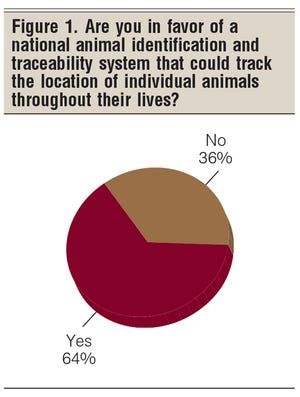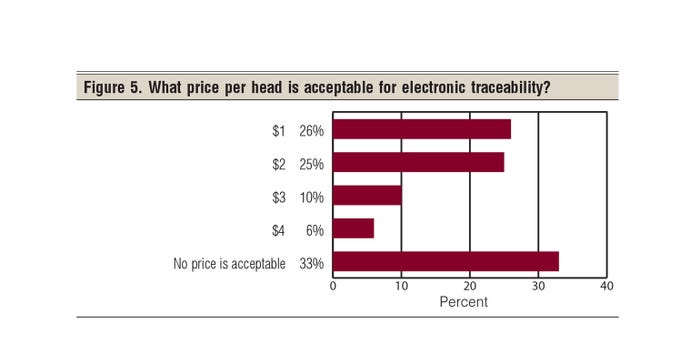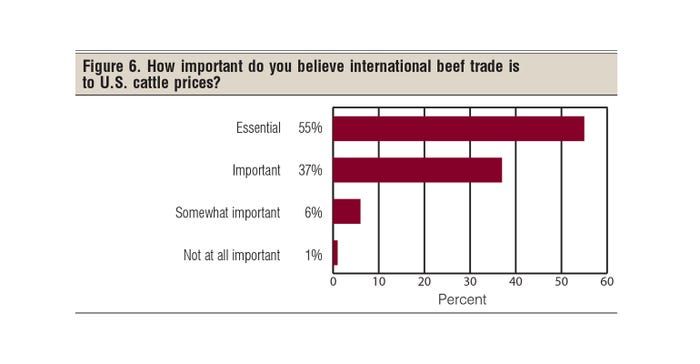As the beef business recovers from the coronavirus, expect the conversation around traceability to heat up.

As this magazine reported last month, BEEF’s annual State of the Industry survey revealed some interesting dynamics in the business, most stemming from COVID-19. One outcome BEEF editors anticipate is an increased focus on cattle traceability.
This focus is not new, of course. Beef producers have been debating whether or not we need lifetime cattle traceability for quite some time.

In the meantime, what did readers say about their thoughts on traceability, and has that changed since a year ago? Here’s a look.
Based on the data, it appears readers haven’t changed their opinion on cattle traceability much at all.
When we asked, “Are you in favor of a national animal identification and traceability system that could track the location of individual animals throughout their lives?” 64% of respondents said yes in the 2020 survey, and 36% said no (Figure 1).
Those responses are only marginally different than what respondents said last year. In the 2019 survey, 62% indicated yes and 38% said no.
For those who said they support national animal ID, we asked why. Topping the list was disease containment and traceback at 80%.
Following that are consumer transparency at 72%, the ability to enter foreign markets at 68%, adds value to calves at 58%, and thwarts cattle theft at 44% (Figure 2). Numbers add up to more than 100% because of multiple responses.

While the ranking changed slightly from 2019, overall the sentiment remained similar. Last year, respondents’ ranks were: 82%, disease containment and traceback; 76%, ability to enter foreign markets; 71%, consumer transparency; 58%, adds value to calves; and 50%, thwarts cattle theft and speeds recovery.
For those who don’t support national lifelong individual animal ID, the biggest reason was the question of who pays for it at 65%.
That’s followed by lack of data confidentiality at 47%, brands and Bangs tags are good enough at 37% potential liability from future buyers at 36%, it’s nobody’s business at 33%, technology concerns at 25%, slows down commerce at 23%, and other at 19% (Figure 3).

Many of the responses showed the independent nature of beef producers, with a concern over government intervention and involvement. “Too much Big Brother already,” one respondent said.
Those responses track closely with the 2019 survey. Concern over who pays for a national ID system topped the responses at 70%, followed by lack of data confidentiality at 50%, brands and Bangs tags are good enough at 35%, potential liability at 34%, it’s nobody’s business at 32%, concerns over the technology at 26%, slows down commerce at 21%, and other at 17%.
Speaking of who pays, respondents to the 2020 survey were evenly split. Packers and producers alike led the list at 39% each, followed by the federal government at 35%, consumers at 32%, state animal health agencies at 23%, and retailers at 20% (Figure 4).

The numbers add up to more than 100% due to multiple answers and indicate that respondents think that the cost should be shared across all segments of the beef marketing chain.
What price per head is best? Respondents indicated that the low end of the range is preferable, with 26% saying $1, 25% indicating $2, 10% at $3, and 6% willing to pay $4. However, 33% said no price is acceptable (Figure 5).

Other results
Changing gears, given the current psychology in the beef business, international trade is on many minds. We asked, “How important do you believe international beef trade is to U.S. cattle prices?
The majority of respondents, 55%, think it’s essential, while 37% said important; 6% indicated somewhat important; and only 1% think it’s not at all important (Figure 6).

That slipped a bit from last year. In 2019, 63% indicated international beef trade is essential, while 30% saw it as important. Somewhat important came in at 6%, and nobody indicated it was not important at all.
When we asked if respondents’ viewpoints on international trade had changed in the last year, 29% said they are more in favor of free trade, 16% are less in favor, 53% haven’t changed their mind, and 1% don’t care (Figure 7).

That’s down from 2019. Last year, 44% said they were more in favor of free trade, 8% were less in favor, 47% were about the same, and 1% didn’t care.
Looking deeper into the beef business, we asked readers if they thought, compared with last year, that the level of unity, or the spirit of cooperation, within the U.S. beef industry had changed.
In 2020, 33% of respondents thought it has stayed about the same, while 17% thought it has improved, 36% said it has decreased, and 14% don’t know (Figure 8).

That’s a change from 2019 as well, particularly in those who think we’re worse off. Last year, 52% of respondents said it remained the same, 18% thought it improved, 18% thought it decreased, and 12% didn’t know.

For 2020, respondents were evenly divided, with 34% who said yes, 32% who said no, and 34% who don’t know (Figure 9). That’s a change from last year as well, when 48% said yes, 25% said no and 28% didn’t know.
Indeed, 2020 is a year unlike none other. Nobody knows what the immediate future holds as the U.S. and the world emerge from their COVID-19 lockdown and economies begin to be resuscitated.
However, people have to eat, and consumers worldwide love U.S. beef.
That’s something positive to hold onto as the beef business tries to salvage what’s left of a year that’s been turned on its head — and look forward to 2021.
About the Author(s)
You May Also Like



